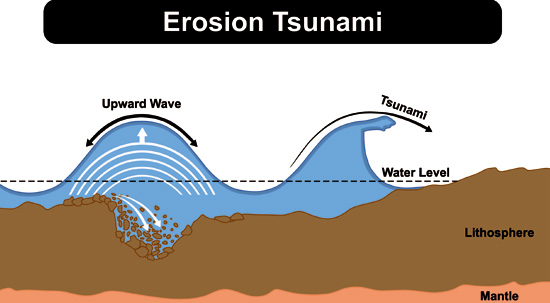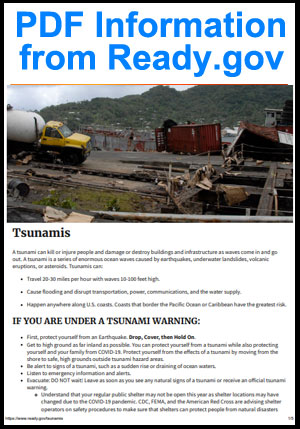Mega Tsunami
Imagine a wave, 600 feet high, traveling at up to 500 miles per hour. It's called a mega tsunami. It's happened before and there are several places in the world where it's going to happen again.
Wikipedia Info
Megatsunamis have quite different features from other, more usual types of tsunamis. Most tsunamis are caused by underwater tectonic activity (movement of the earth's plates) and therefore occur along plate boundaries and as a result of earthquake and rise or fall in the sea floor, causing water to be displaced.
Ordinary tsunamis have shallow waves out at sea, and the water piles up to a wave height of up to about 10 metres (33 feet) as the sea floor becomes shallow near land. By contrast, megatsunamis occur when a very large amount of material suddenly falls into water or anywhere near water (such as via a meteor impact), or are caused by volcanic activity.
They can have extremely high initial wave heights of hundreds and possibly thousands of metres, far beyond any ordinary tsunami, as the water is "splashed" upwards and outwards by the impact or displacement. As a result, two heights are sometimes quoted for megatsunamis – the height of the wave itself (in water), and the height to which it surges when it reaches land, which depending upon the locale, can be several times larger.
Original Wikipedia Link: https://en.wikipedia.org/wiki/Megatsunami
Megatsunami Scenario - La Palma Landslide
For the record, there are some errors in distance stated in this video. That of course calls into question the credibility of anything else they say. However, the reason I chose this video is because it illustrates the concept nicely.
Tsunami Visualization
La Palma Mega Tsunami.mov
This movie shows a physics-based computer simulation of a Mega Tsunami generated by a flank collapse of La Palma, Canary Islands. The movie focuses on the maximum expected runup of the waves on the shores of the Atlantic Ocean.
Past and Present Threats
From Wikipedia: Modern megatsunamis include the one associated with the 1883 eruption of Krakatoa (volcanic eruption), the 1958 Lituya Bay megatsunami (landslide into a bay), and the wave resulting from the Vajont Dam landslide (caused by human activity destabilizing sides of valley). Prehistoric examples include the Storegga Slide (landslide), and the Chicxulub, Chesapeake Bay and Eltanin meteor impacts.
News Article: Looming Landslide in Alaska Could Trigger Enormous Tsunami at Any Moment, Scientists Warn
LINK: https://earther.gizmodo.com/looming-landslide-in-alaska-could-trigger-enormous-tsun-1843479019




How to Prepare in Case of a Tsunami | Disasters
Preparation - Survival
Click Here for information on what to do from the United States government website, Ready.gov.
Click Here for the Red Cross Tsunami Preparedness Information.
Click Here to download a PDF file with information on what to do from the United States government website, Ready.gov.
Additional Preparation Tips
1. If you are in the impact zone, find out how to monitor what would trigger the wave.
That might mean tracking volcanic activity of La Palma; monitoring earthquakes in areas that could trigger a mega tsunami; or watching for changes in temperature or rainfall in places like Alaska and Greenland.
2. Plan an evacuation from the impact area. Since mega tsunamis can move several miles inland, it's important you have at least two paths to get out of the way.
3. Test your evacuation plan. In the best case scenario, how long does it take? Now triple the time to allow for traffic jams or masses of people panicing. From the time you would be notified, will you be able to get out?
4. Do you have a go-bag? That's a pre-packed bag of supplies that you can grab as you're running out the door.
5. In places like islands, do you have access to airplanes that can take you above the wave? If not, find the highest and strongest point you can evacuate to that might offer protection. Time how long it takes you to get there and what permissions you would need to get in if it's a restricted area.
6. Business owners need to consider if special policies to cover an event like this are available or affordable. If you're not insured, be prepared to lose everything in an event like this. Even if you are insured, there is no guarantee the insurance company will remain solvent to pay out the claim if it's a worldwide event. Make sure your carrier has the financial resources to deal with something like this.
7. Supplies for the aftermath. You need to be self-sufficient for a minimum of 2 weeks, potentially much longer. That means you need shelf-stable food, clean water, basic medical supplies and communication systems.
Return to 101 Ways to Die Home Page
This information is presented to make people aware of the larger world around them. If you can prepare for something as devastating as this, you're much more likely to be ready for smaller disruptions. Be aware and prepare.
5/24/2020
Updated 4/15/2021
Updated 9/23/2022



